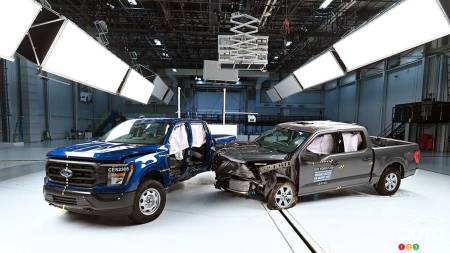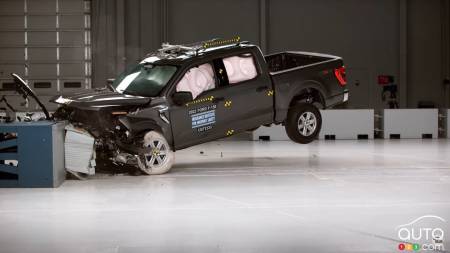• The IIHS has highlighted rear-seat safety issues in full-size pickup trucks.
Full-size pickup trucks just keep getting bigger. For some buyers, this confers a greater sense of security. The reality can be quite different.
In a recent battery of tests conducted by the IIHS (Insurance Institute for Highway Safety), it was found that full-size pickups can better protect rear-seat occupants in frontal collisions.
Also, it's worth mentioning that thanks to their higher seating position, all four models in the class (Chevrolet Silverado 1500, Ford F-150, Ram 1500 and Toyota Tundra) performed well in the new side impact tests.
However, in the new moderate overlap frontal crash test, the Silverado 1500, F-150 and Ram 1500 all scored Poor, the agency's lowest rating. The Toyota Tundra earned a better Marginal rating, still not Good or Acceptable.

In the new moderate overlap crash test, the vehicle travels at a speed of 40 mph (64 km/h) to hit a barrier that covers 40 percent of the model's width.
This test was updated in 2023 to focus more on rear occupant safety. According to the IIHS, its research showed that “in newer vehicles the risk of a fatal injury is now higher for belted occupants in the second row than for those in front.”
The agency says this is not because the second row has become less safe, but because front seat safety has improved. Most of the features that make front seats safer (such as improved airbags and seat belts) are rarely installed in the rear seats.
Another factor to consider is that the IIHS now uses smaller dummies in the rear, to simulate the presence of a 12-year-old child or a smaller woman. Sensors installed on these dummies measure the forces exerted on the head, neck, chest and legs. The IIHS also records how seatbelts hold dummies in position for optimal protection.
This is often where potential injuries are observed. As a result, the IIHS concludes that better belts are needed at the rear.
In this case, with all four trucks, the rear-seat dummy slid forward a little under the lap belt, increasing the risk of injury. The IIHS noted that chest, neck and head injuries were likely with the Ford-150 and Ram 1500. The risk was slightly lower with the Chevrolet Silverado 1500. The situation is only slightly better with Toyota, where incorrect positioning of the seatbelt could result in a high risk of chest injury.
We can expect to see rear safety improved in models from now on, especially with new belts that will keep occupants of all sizes in place.





